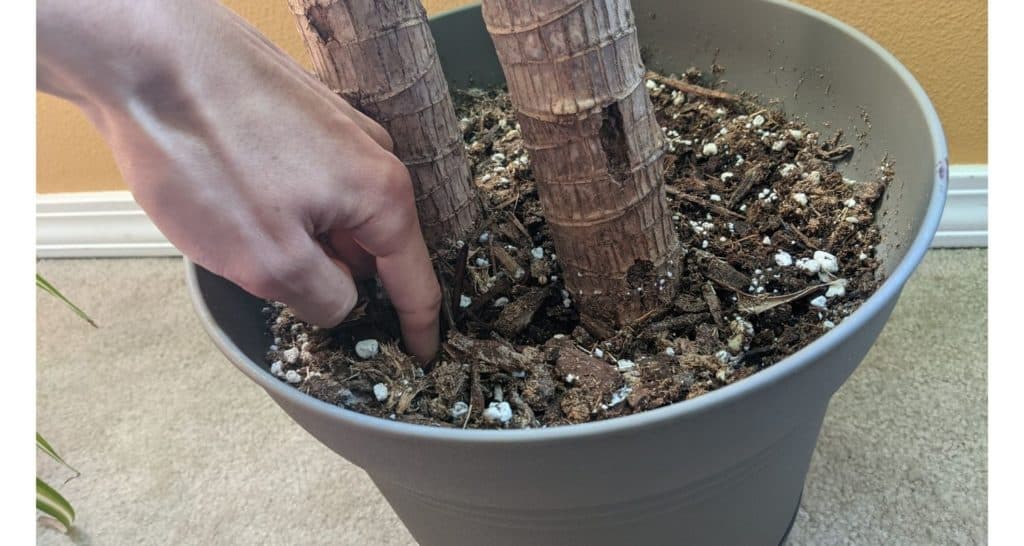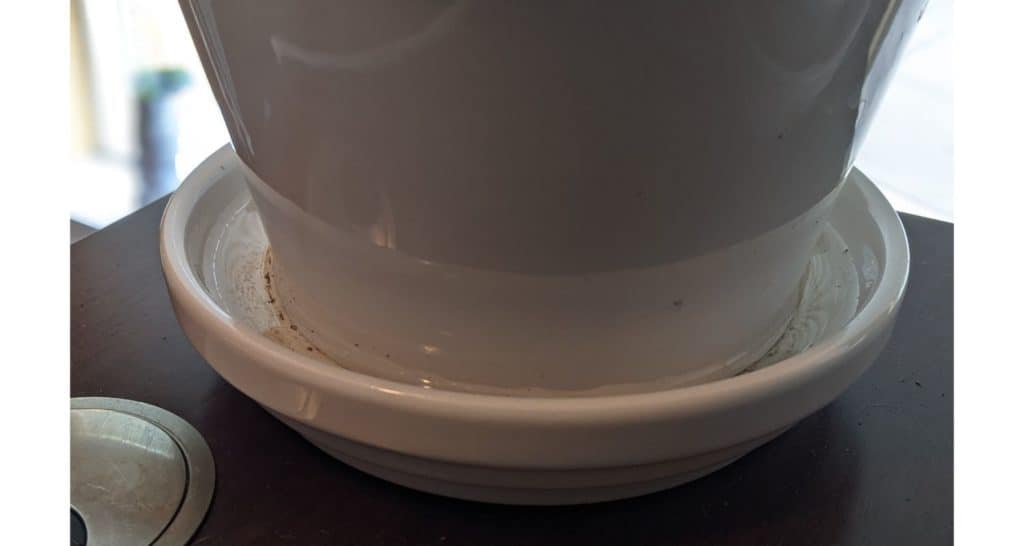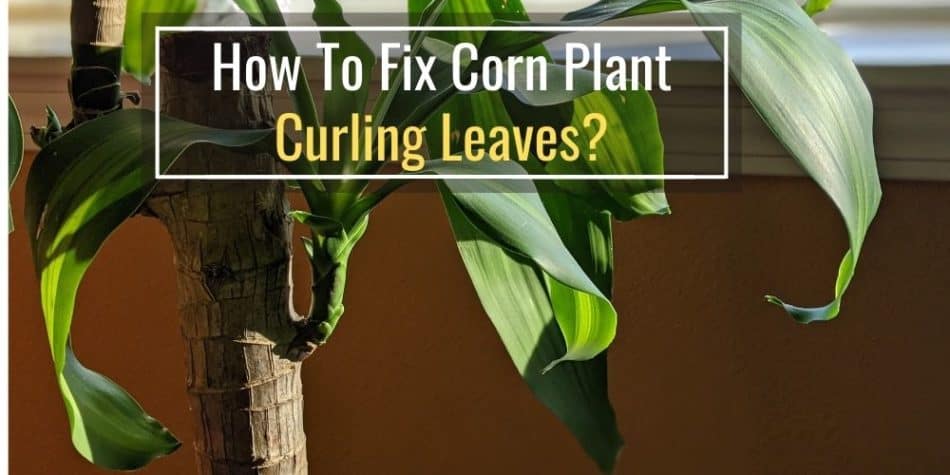If you’ve started to notice that the beautiful long green leaves of your dracaena fragrans, also known as corn plants, have started to curl, do not panic.
A wide variety of causes as well as solutions are outlined below for curling leaves.
Dracaena fragrans (corn plant) leaves will curl as a result of overwatering, underwatering, excessive light, dry air, heat, pests, excessive fertilizer, tap water, or disease. The best solution is to place the corn plant in an area that receives bright, indirect sunlight and water every 1 to 2 weeks. Overtime the corn plant’s leaves will uncurl once it receives the right growing conditions.
The good news is that curling leaves is an early sign of an unhappy plant so there is still plenty of time to diagnose and fix the issue.
Lets cover over the most common reasons why a dracaena fragrans (corn plant) will have curling leaves.
Overwatering Dracaena Fragrans (Corn Plant) Can Cause Leaves to Curl
Dracaena fragrans plants require regular watering in order to survive. However, watering too frequently or too much will lead to overwatering.
Overwatering a corn plant, or any houseplant, can lead to root rot which will cause the leaves to curl.
In order to determine when to water a corn plant, place your index finger 1 inch into the soil. I stick my finger in the soil up to my second knuckle.
- DO NOT water the corn plant if the soil is still moist
- Water the corn plant if the soil is dry

Make sure there is a drainage hole at the bottom of the corn plant’s pot in order to let excess water out. Pooling water at the bottom of the pot can lead to root rot and other issues.
Underwatering Causes Dracaena Fragrans (Corn Plant) Leaves to Curl
Similar to the issue of overwatering, too little water can also cause the leaves of dracaena fragrans to curl.
The corn plant’s leaves may also look a little dry or crunchy which is a telltale sign that underwatering is the issue.
In order to determine when to water a corn plant, place your index finger 1 inch into the soil. I stick my finger in the soil up to my second knuckle.
- DO NOT water the corn plant if the soil is still moist
- Water the corn plant if the soil is dry
As long as the soil is moist 1 inch or deeper than the plant can drink water when it needs to.
Dracaena Fragrans (Corn Plant) Leaves Can Curl Due to Excessive Light
Excessive light is tied to lack of water. If your window lets in a lot of light then the temperature rises which causes the water to evaporate more quickly. As a result, the leaves can curl.
The best solution is to move the corn plant to another location or further away from the window. As long as the corn plant is not getting direct sunlight than the plant should be fine.
Remember that hotter or sunnier months may cause the corn plant to dry out faster so the plant may need to get watered more frequently.
In order to determine when to water a corn plant, place your index finger 1 inch into the soil. I stick my finger in the soil up to my second knuckle.
- DO NOT water the corn plant if the soil is still moist
- Water the corn plant if the soil is dry
Dry Air Can Cause Dracaena Fragrans (Corn Plant) Leaves to Curl
Dry air from a heater vent will dry out the leaves of any house plant. As a result, the leaves curl so that they require less water to survive.
The best solution is to try watering the plant more often or moving the plant to another location so it is not being hit by hot or dry air.
If the air is extremely dry where you are located then try watering the plant until it drains through to the plant pot.

Have a saucer underneath to catch the excess water which will allow the plant to soak or suck up extra water as the soil dries out.
Heat Can Also Cause Dracaena Fragrans (Corn Plant) Leaves to Curl
Similar to the issues of dry air or excessive light, a hot climate will cause the water to evaporate more quickly. The corn plant will not receive as much water as it needs if the climate is too hot, which will cause the leaves to curl.
The corn plant’s leaves may also look a little dry or crunchy which is a telltale sign that the plant is not receiving enough water.
Make sure that the plant is not sitting in direct sunlight, a warm room or location such as near a radiator or heater during winter.
The best solution is to move the plant to a cooler location and water it more frequently if the climate is warmer than usual.
Pests Can Cause Dracaena Fragrans (Corn Plant) Leaves to Curl
Although it is not a common issue, pests can create a serious problem for your dracaena plant.
A few signs to look out for are tiny cobwebs caused by spider mites or white powder caused by mealybugs. Another sign to look out for a tiny green, white, black, or red soft-bodied bugs around the leaves – these are aphids and they will suck the moisture out of the plant.
If you see any signs of these types of pests then try spraying your plant with homemade insecticide made from castile soap, water, and a spray bottle. Read this guide to learn how to make homemade soapy spray that is safe to spray on plants.
Spray the soapy sprays as often as needed and the pests should be removed after 2 weeks of treatment.
Dracaena Fragrans (Corn Plant) Leaves Can Curl Due to Excessive Fertilizer
Similar to how overwatering a plant causes issues, overfertilizing or feeding a plant can also cause issues.
Feeding the corn plant with too much fertilizer will damage the roots which means the nutrients will not make their way to the leaves of the plant. As a result the leaves will start to curl.
The best solution is to re-pot the plant with indoor potting soil and fertilize on the recommended schedule for indoor plants. Each fertilizer brand is different so make sure to read and follow the instructions.
Typically it is better to under fertilize a plant than overfertilize it.
Tap Water May Cause Dracaena Fragrans (Corn Plant) Leaves to Curl
Tap water contains a variety of different minerals, salts, and additives depending on your local water quality.
These salts can accumulate in the soil of your plant which will alter the soil quality. As a result, the corn plant will be unable to access all the nutrients it needs to survive.
There are two ways to prevent this from being an issue.
- Use filtered or spring water
- Fill a watering can with tap water and let it sit for 24 hours before watering the plants
Letting tap water sit for 24 hours or longer will allow the salts to sit to the bottom of the pot and other contaminants to evaporate off. So make sure not to pour water from the bottom of the pot as that contains all the salts.
Dracaena Fragrans (Corn Plant) Leaves May Curl as a Result of Disease
The most common disease with corn plants is root rot due to overwatering. However, root rot can also be caused by fungus, excessive fertilizer, or lack of oxygen.
The best way to determine if your corn plant has root rot is to remove it from the pot and gently shake off the excess dirt. You can also spray the roots with water so you can inspect the roots.
Roots that are healthy will be firm and white in color. If the roots have root rot then they will be soft and black or brown in color. Remember root rot is typically caused by roots sitting in too much water.
Assess this issue carefully before taking action as you may have to repot your plant or replace it.
Final Thoughts
Dracaena fragrans (corn plant) is a beautiful plant to grow indoors. They can liven up a space since they will grow tall and extend their vibrant green and yellow leaves.
However, make sure to pay attention to any symptoms of stress from the corn plant such as curling leaves. As long as you pay close attention to this plant, it will continue to thrive for many years to come.

